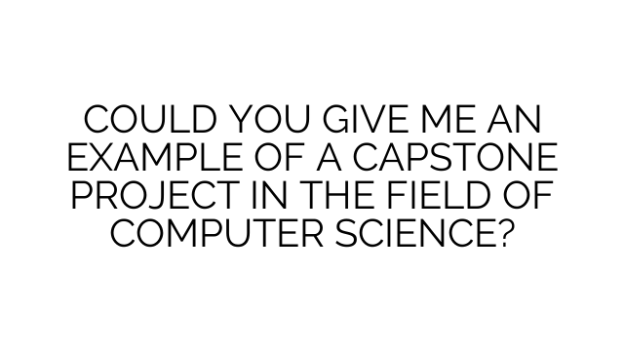One example of a capstone project in computer science would be developing a customized medical information system for a clinic or hospital. For a project of this scope and scale, students would work in a team to analyze requirements, design the system architecture, develop the necessary code and applications, implement security features, test all aspects of the system, and deploy it for real-world use at the medical facility.
In the initial phases, the student team would work closely with administrators, doctors, nurses and other medical staff at the facility to understand their detailed workflow processes, data storage and reporting needs, and systems integration requirements. This requirements gathering and analysis phase is crucial to understand all of the features and functionality that must be included in the custom medical information system. The team would document gathered requirements, perform gap analysis on current workflows versus desired future state, and prioritize features to ensure the system addresses top priorities and pain points.
With a comprehensive understanding of requirements in hand, the student team would then begin designing the system architecture. Key consideration would include decisions around database structure and schemas, backend application design using appropriate programming languages and frameworks, front-end user interface designs for various user roles (doctors, nurses, administrators etc.), integration with existing practice management systems or electronic health records if needed. Important non-functional requirements around security, privacy, performance, scalability and maintainability would also influence architectural design decisions.
Detailed documentation of the system architecture design would be created, covering database models, application component diagrams, interface wireframes, infrastructure requirements and more. Students would present and defend their proposed architecture to stakeholders to obtain feedback and approval before moving to implementation.
The implementation phase represents the bulk of effort for the project where students translate designs into working code and applications. Key activities would include:
Building out the backend applications using languages like PHP, Python, Java or .NET to implement the required functionality based on requirements and architectural designs. This includes developing APIs, business logic and integration layers.
Creating a frontend UI using HTML, CSS and JavaScript frameworks like React or Angular that adheres to user experience designs and provides role-based interfaces.
Setting up and configuring a database like MySQL, SQL Server or MongoDB based on the data models and architecting appropriate schemas, indexes, foreign keys etc.
Populating the database with sample test data including demo patient records, appointment schedules, insurance profiles and more to enable thorough testing later.
Integrating the custom system with other existing medical facility systems like practice management software or EHR products through pre-defined APIs.
Implementing security features like multi-factor authentication, authorization controls, encrypted data transfer and storage, input validation etc. based on a thorough security risk assessment.
Developing comprehensive installation, configuration and operation guides for medical staff.
Performing extensive testing of all functionality from different user perspectives to uncover bugs. This includes unit testing code, integration testing, user acceptance testing, load/stress testing and more.
Once development is complete, the student team would help deploy and launch the new medical information system at the partner medical facility. This includes performing the necessary installation and configuration activities, onboarding and training of medical staff, addressing any post-deployment issues, and measuring success based on defined key performance indicators.
Ongoing maintenance and improvements to the system over several months post deployment may also be part of the project scope, requiring the team to monitor system performance, implement requested enhancements, and resolve production issues.
In the concluding project phases, the student team would document the complete system development lifecycle and create a comprehensive final report. An oral presentation would be given to stakeholders highlighting achievements, lessons learned, future roadmap for the system and reflections on career readiness gained through such a hands-on capstone project experience.
An example medical information system capstone project as outlined above covers the full scope from requirements analysis to deployment, addresses real-world problems through technical solutions, and provides students an in-depth industry-aligned experience to showcase their cumulative skills and knowledge gained throughout their computer science education. Completing a complex project of this scale truly allows students to synthesize their learning and strengthens their career preparedness for jobs in both software development and healthcare IT fields.
